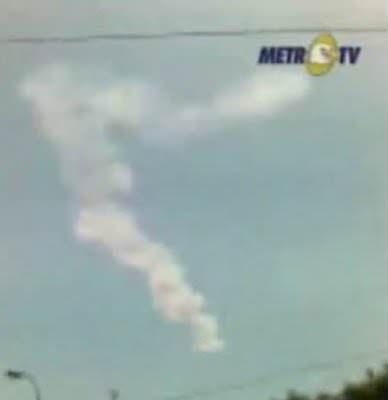This has taken awhile to filter into the Western press, but an asteroid exploded over the town of Bone,Indonesia on October 8th at around 11am local time. Initially, locals called the police to report that a plane had crashed, or that an earthquake shook the ground, as reported in the Jakarta Globe. The Jakarta Post quoted Thomas Djamaluddin, head of the Lapan Center for Climate and Atmosphere Science Implementation as saying that the explosion was due to a meteorite or bit of space junk that had entered the Earth’s atmosphere. As it turns out after further analysis, the explosion was due to an asteroid about 5-10 meters (15-30 feet) in diameter exploding in the air between 15 and 20 km (nine to 12 miles) above sea level. Nobody was injured as a result of the explosion, but it evidently caused quite a scare with the local population!
In a press release from the Near Earth Object (NEO) program, the explosion was detected by many International Monitoring System (IMS) infrasound stations, five of them 10,000 km (6200 miles) away, and one 18,000 km (11,100 miles) from the blast. These stations monitor seismic waves, infrasound (low frequency soundwaves), hydroacoustic, and radionuclide emissions as part of the Comprehensive Nuclear-Test-Ban Treaty Organization (CTBTO). They are well equipped to monitor explosions of nuclear weapons, but also detect other events such as meteorite impacts and asteroid explosions, tsunamis and earthquakes.
When analyzed, the amount and intensity of low frequency sound waves created by the explosion allowed researchers Elizabeth Silber and Peter Brown of the Meteor Infrasound Group at the Univ. of Western Ontario to determine that the explosion caused by the asteroid was on the scale of 30 – 50 kilotons of TNT. To give you an idea of how powerful of an explosion this is, the bombs dropped over Hiroshima and Nagasaki in World War II exploded with the force of 20 kilotons of TNT.
The fireball – also called a bolide – created a dusty tail upon entering the atmosphere of the Earth. It is estimated that the asteroid was traveling around 72,000 km/hour (45,000 miles/hour) when it hit the atmosphere. As an asteroid enters the thick Earth atmosphere, it slows down abruptly and heats up due to the process of ablation. If this asteroid were made of metal instead of rock, it would likely have impacted the ground causing a lot of damage. Fortunately for the residents of Bone and the surrounding area, the rock broke up in a large fireball instead. There haven’t been any reports of pieces that have touched down as of yet.
Asteroids of this size are predicted to impact the Earth about every 2-12 years, and the last one of this magnitude was a bolide over the Marshall Islands on February 1, 1994. That impactor was estimated to be between 4.4 and 13.5 meters. A full analysis of that event is available on the SAO/NASA Astrophysics Data System.
Of course, events like this always raise the question of why the object wasn’t detected before it even entered the atmosphere. The NEO program has cataloged over 600 objects in the size of 10 meters, but there are many, many more out there. The cost of a monitoring and cataloging all of the Near Earth Objects would be in the hundreds of millions of dollars, but more events like this may spur the political will and capital to further efforts at protecting human lives from the potential damage of meteorite impacts.
Source: Night Sky, Spaceweather.com, JPL Press Release


I suppose we might want to think a bit more about meteoroids and asteroids. With a diameter of between 4.4 and 13.5 meters that is a bit close for comfort.
LC
Hmm – makes one think a bit more about investing in technology to identify and track these smaller yet still potentially devastating threats…
In the 10 years or so, we’ve seen an amazing number of comets come round Sol.
C. Schwasman-Wachmann stands out as one of the most spectacular examples as does C. Holmes. As a result we probably shouldn’t be too surprised to see an iincreased number of large bolides intercepting earth’s orbit.
It would not be entirely unreasonable to expect more in the way of large bolide events?
KA BANG! Or is that ‘Trick or Treat’?